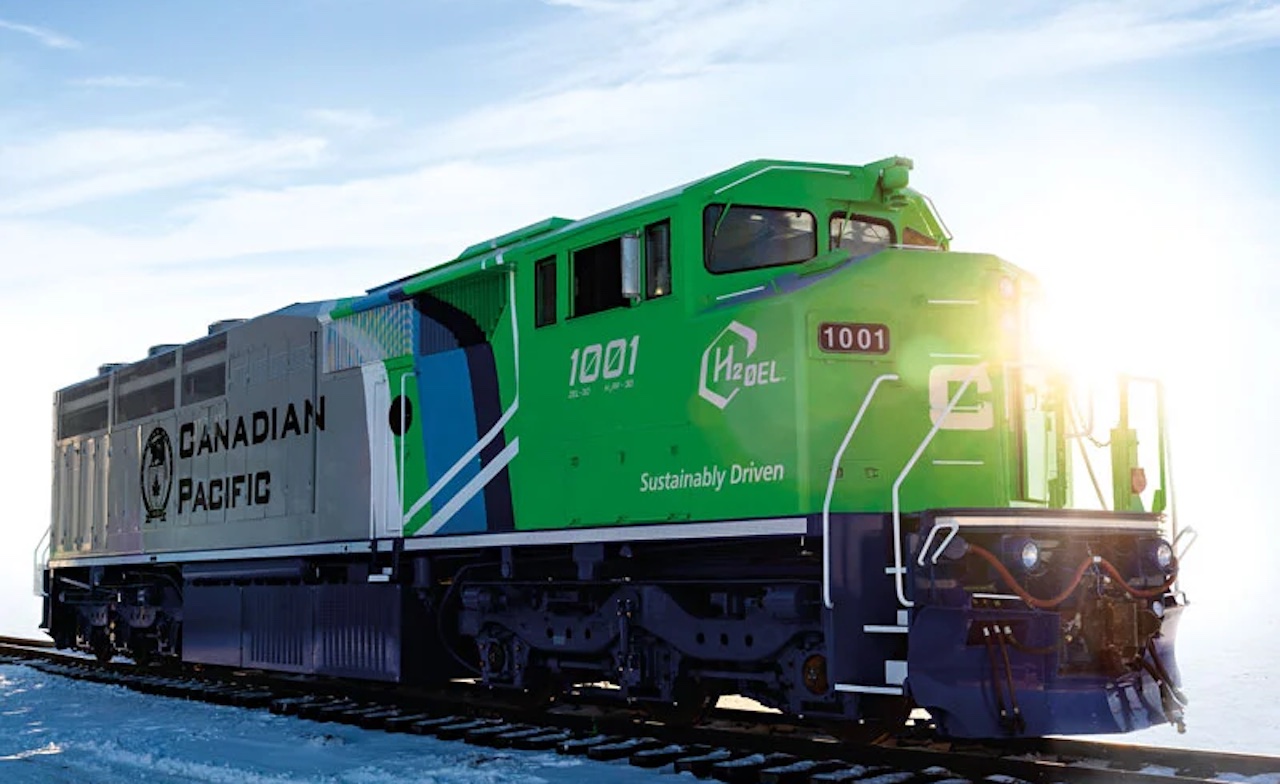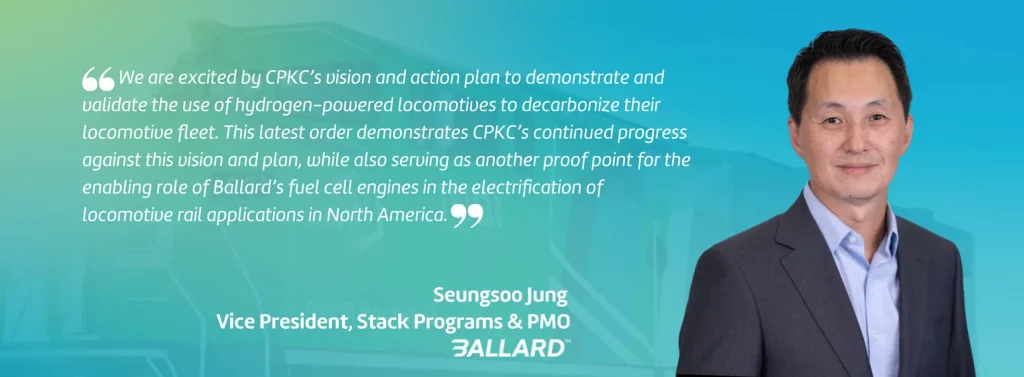
Supply Side: Ballard, Rail Vision
Written by Carolina Worrell, Senior Editor
Ballard Power Systems (Ballard) receives an order of additional fuel cell engines from Canadian Pacific Kansas City (CPKC). Also, Rail Vision ltd. (Rail Vision) reveals its next-generation AI (Artificial Intelligence) computer for railway safety and accident prevention and is granted a patent approval from the Indian Patent Office.
Ballard
Ballard recently announced that it has been awarded an additional order of 12 fuel cell engines from CPKC to be delivered in 2024. The 200kW FCwave™ engines will support the expansion of CPKC’s new fleet of hydrogen-powered locomotives planned for regular switching and local freight service applications in Alberta, Canada.
To date, Ballard has supplied CPKC with 50 fuel cell engines for use in its hydrogen locomotives, with combined fuel cell power of 10MW. The additional locomotives are expected to enter service by the end of this year.
“Our hydrogen locomotive program demonstrates our commitment to reduce greenhouse gas emissions and we are pleased to continue to work with the team at Ballard to implement effective alternative fuel solutions,” said CPKC AVP Operations Technology Dr. Kyle Mulligan.
Since 2021, Ballard has supplied CPKC with fuel cell engines for use in three different types of locomotives, “which have undergone subsequent and successful field testing, proving the capabilities of Ballard’s hydrogen fuel cell technology in locomotive applications,” according to the company. Further development on range across temperature variations, heavy hauling, fine tuning auxiliary load to avoid waste, and increased number of hours on current and additional units will support continued technological evolution.
The success of these trials, combined with the need to achieve CPKC’s emissions goals, has resulted in the significant expansion of the original hydrogen locomotive program.

The locomotives will be partially funded through the Emissions Reduction Alberta (ERA) program, which helps the province deliver on its environmental and economic goals. This in turn supports the decarbonization of rail transport by funding hydrogen production and refueling infrastructure along with hydrogen-powered locomotives.
Further Reading:
- Ballard Receives Order From CPKC for Additional Fuel Cell Engines
- CP’s Hydrogen Locomotive Program Advances
- CP’s Hydrogen Locomotive Powers Up
- Ballard to Power CP’s Expanded Hydrogen Locomotive Program
- First Look: CP’s Hydrogen Zero Emissions Locomotive
Rail Vision
Israel-based technology company Rail Vision recently announced its next-generation AI-based computer to be incorporated in its Main Line and Switch Yard systems.
This advanced system, Rail Vision says, represents a major evolution from the company’s existing AI-based solutions, featuring advanced real-time deep learning capabilities and compliance with stringent railway standards.
According to the company, Rail Vision’s system “ensures exceptional performance in obstacle detection and identification, even under challenging weather and visibility conditions. Its real-time operational capacity in both software and firmware contributes to a new era of responsiveness and efficiency in railway safety management.”
Furthermore, Rail Vision says the system’s design focuses on scalability, “ensuring the system remains at the forefront of technological advancements. The integration of cloud connectivity opens new avenues for data analysis and predictive maintenance, enhancing the overall safety and operational efficiency of railway networks.”
“Rail Vision’s next-generation AI computer system is a significant milestone in railway safety technology,” said Rail Vision CEO Shahar Hania. “This innovation embodies our unwavering commitment to advancing railway security, marrying cutting-edge AI with real-time processing to prevent accidents and save lives. Our system, technology and cloud connectivity are transformative leap forward, marking a new chapter in intelligent railway operations.”
Separately, on Feb. 5, Rail Vision announced that it has been granted a patent approval from the Indian Patent Office.
The patent, titled “SYSTEM AND METHOD FOR OBJECT AND OBSTACLE DETECTION AND CLASSIFICATION IN COLLISION AVOIDANCE OF RAILWAY APPLICATIONS,” has already approved in the U.S. and Japan and is pending approval in Europe and China.
According to Rail Vision, the patent covers the method for detection and identification of objects and obstacles near, between or on railway. The method refers to several forward-looking imagers adapted to cover all vision ranges and is also sensitive to each different wavelength of radiation. Electro optic sensors (e.g. thermal infrared imaging sensor and visible band imaging sensor) are used to survey and monitor railway scenes in real time.
Rail Vision’s Main Line system utilizes advanced vision sensor technology, incorporating engineering, big data, and AI that is installed directly on trains. This system is capable of collecting data, including weather information, in real time and from remote locations accessible exclusively by railway routes.
“India, with its vast and busy railway network, is a huge potential market for our advanced technology,” said Hania. “The approval of our patent, already recognized in the US and Japan and pending in Europe and China, reinforces our commitment to enhancing railway safety and operational efficiency worldwide.”
According to India Brand Equity Foundation, a trust established by the Department of Commerce, Ministry of Commerce and Industry, Government of India, India has the fourth largest railway network in the world with more than 22,593 operating trains (9,141 freight and 13,452 passengers) with a daily passenger count of 24 million passengers and 203.88 million tons of freight.
In 2022, passenger traffic stood at 3.54 billion as compared to 1.28 billion in 2021. Total revenue from traffic in India for 2022-23 is estimated to be $28.93 billion, an increase of 19% over revised estimates for 2021-22. Freight revenue in India is estimated to be $19.92 billion in 2022-23, an increase of 14% over the revised estimates for 2021-22. The passenger revenue in India is estimated to be $ 7.06 billion, an increase of 32% over a low base in 2021-22.



